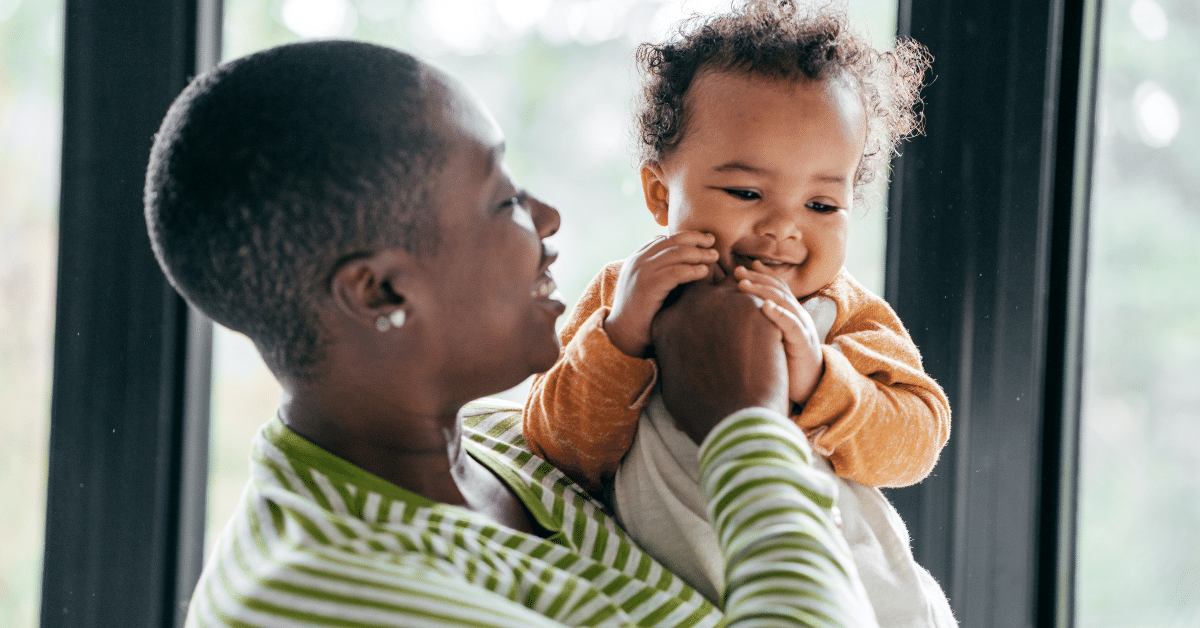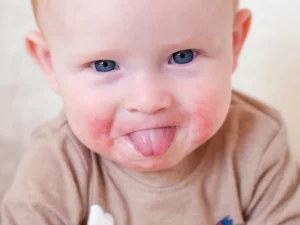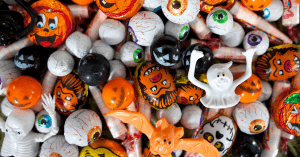
All babies drool, but saliva on skin can cause a drooling rash near the mouth. From symptoms to treatment, here’s what to know about drool rash.
What is Drool Rash?
Drool rash, also known as drooling rash or newborn rash, is a type of contact dermatitis caused by excessive drool settling on the skin and irritating babies’ sensitive skin.
Babies develop their salivary glands around 2 to 3 months, which is when drool rash can begin, and they typically stop drooling when they’re around 15 to 18 months old. However, drool rash is most common when babies are teething. Babies drool the most while teething because they have new teeth cutting through their gums.
Additionally, pacifiers and teething rings can increase the risk of drool rash since they cause contact between saliva and the skin.
Related: Tips for Helping Your Teething Tot
What Does It Look Like?
Drool rash often looks like a bumpy red rash, often around babies’ mouths, chins, and necks. This image via Medical News Today shows what drool rash around the mouth may look like. If the rash appears more severe, including oozing or blistering, you should contact your child’s doctor for treatment.

How Do You Treat Drool Rash?
Drooling is a natural part of growing up, so how can you prevent your baby from developing a drooling rash or help an existing rash clear up? The easiest way to treat it is to prevent further contact between saliva and the skin as much as possible. Putting your baby in an absorbent bib and changing it when needed, as well as wiping excess saliva from their mouths, is the most effective way to reduce saliva’s contact with the skin.
To help the rash heal faster, you can gently clean the irritated area with warm water and a washcloth twice a day, making sure to pat the skin gently rather than rubbing the rash. After cleaning, you can apply a barrier cream or ointment such as petroleum jelly to help the rash heal faster. Avoid applying lotions or products with fragrance, and ask your child’s doctor if you aren’t sure whether a product is safe for your baby’s sensitive skin.
Is Drool Rash Contagious?
It isn’t contagious, and it also isn’t connected with any underlying medical conditions.
Does It Hurt?
It may be uncomfortable and itchy for your baby, but it isn’t a serious medical issue.
Should I Contact a Doctor About Drool Rash?
While drool rash on its own is harmless, you should contact a medical professional if your baby shows more severe symptoms like these:
- The rash lasts for more than a few days and isn’t responding to treatment.
- The rash is cracking, oozing or blistering, which could indicate the rash is infected.
- Your baby seems very uncomfortable with the rash.
- Your baby has a fever.
A doctor will be able to prescribe a treatment like an over-the-counter cream that should clear up your baby’s drooling rash in no time.
In Short, What Should I Know About Drool Rash?
Drool rash is a bumpy red rash around babies’ mouths caused by saliva touching and irritating their skin, often when they’re teething. There are three easy ways to treat it. First, you can prevent saliva from touching the skin with an absorbent bib. Second, you can gently clean the area with warm water and a washcloth. Third, you can apply a barrier cream like petroleum jelly to the rash. It isn’t contagious or overly painful, but if your baby has more severe symptoms, you should contact their doctor for treatment.
Related: Tips for Helping Your Teething Tot
How We Wrote This Article
We wrote this article using trusted medical sources, including the American Academy of Pediatrics and Mount Sinai. The advice in this article should not replace expert medical consultation, and you should contact medical professionals for official diagnoses and treatments.
Sources we cited:
American Academy of Pediatrics, Drooling and Your Baby
Mount Sinai, Special Topic: Teething
Scripps Health, Baby’s Drool Rash: How To Treat and Prevent It


